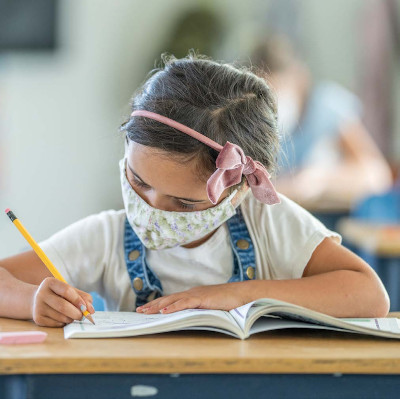Chronic Absenteeism: Best Practices to Increase Student Attendance
Causal Research to Address Chronic Absenteeism: A Research Brief on Best Practices to Increase Student Attendance
March 2024

Introduction
School leaders everywhere are grappling with student chronic absenteeism, which has reached crisis levels in the post-pandemic era. Students cannot learn if they are not in school, and attendance problems can affect classmates’ performance as well. This brief aims to aid policymakers and school leaders by sharing lessons from the most rigorous research available. It describes chronic absenteeism solutions to common causes of absenteeism, and the recommended approaches are limited to ones that have been shown to causally reduce student absenteeism. It focuses on Virginia, but the implications are applicable for other states as well.
Background
By the end of the 2022-23 academic year, 28% of public school students nationally were “chronically absent” — missing more than 10% of the school year. In Virginia, 19.3% of students were “chronically absent”— lower than the nation but still well above pre-pandemic levels and including 1 in 4 chronically absent children from the most vulnerable populations.i ii iii Chronic absenteeism is a pernicious problem: it negatively and substantively affects students’ academic outcomes, ontime high school graduation, college enrollment, and age-appropriate socioemotional skill development.iv v Moreover, a chronically absent student negatively affects their classroom peers’ educational outcomes.vi vii This evidence, in conjunction with accountability mandates, underscores why it is essential to mitigate chronic absenteeism.
Root Causes of Chronic Absenteeism
Typically, a combination of factors contributes to chronic absenteeism; however, research identifies common factors across contexts that schools can influence, which we group under two meta-causes: Family Disengagement and Confusion and Student Disengagement. To assist districts and schools in determining which intervention(s) to adopt, we link each to meta-causes, which we discuss below.
Family Disengagement and Confusion

Typically, families underestimate their child’s absences and believe their child’s absenteeism record is average compared to their peers. viii Additionally, many families underestimate the negative effects of absenteeism; this is especially true of families of elementary students who often assume attendance is less important because they assume that the typical school day includes rudimentary content and organized play.ix
In addition, the expectations regarding illness and keeping children home changed substantially during the pandemic. Schools expected families to keep their children home if a child presented any symptoms, even for the common cold. Schools have largely dissolved these expectations reverting back to pre-pandemic norms. However, parents may not be aware that schools have changed their expectation and now expect families to send children who are not severely ill, taking advantage of masking to stop the spread to classmates. In addition, families may still have anxieties about their children getting sick, especially as other viruses, such as RSV, continue to spread. Educating families on the expectations regarding when children should stay home versus when they can come masked may improve attendance for those who are still adhering to expectations during the pandemic. Parents should be encouraged to consult their pediatrician or school nurse regarding when it is safe to send their child to school.
Student Disengagement

Students who are disengaged and socially isolated are more likely to become chronically absent. x Children who do not engage with peers or adults positively can develop negative perceptions about school, resulting in increased avoidance and higher absences.
It has also become increasingly common for adolescents to experience mental health issues. Individuals struggling with their mental health often have difficulty engaging socially with peers or engaging in school activities, yet peer socialization is essential to appropriate development for this age group.xi The Virginia Department of Health found that 30% of students in Northern Virginia experience feeling sad or hopeless, and over 12% considered suicide at some point.xii
38% of Virginia high school students report never or rarely receiving the help they need when in emotional distress.xiii These conditions likely contribute to chronic absenteeism.
Solutions to Address Chronic Absenteeism
School-to-Home Family Engagement and Information
Informational Mailers and robust Two-Way Messaging systems can reduce chronic absenteeism by mitigating problems stemming from family disengagement or misconceptions.
Informational Mailers
Informational Mailers have been studied in all grades in racially diverse student populations in urban, rural, and suburban districts. Mailers mitigate misinformation by providing families with accurate attendance data about their students and dispelling misbeliefs about the effects of missing school by reminding families about the importance of attendance.xiv xv xvi Sending mailers throughout the year improves average attendance by 1.1 days per student.xvii Notably, Informational Mailers are among the lowest cost interventions – $0.53 per postcard – and costs can be reduced further by sending attendance mailers home with report cards or progress reports.
Next Steps:
Many Virginia districts already share attendance information with families. As a next step, educational leaders might redesign mailers to emphasize attendance data and consider adding district, school, or “peer group” average attendance rates to place a student’s absences in context, which research suggests can enhance the impact.
Two-Way Messaging system
A study in an urban school district focusing on K-1 students implemented a Two-Way Messaging system to increase family engagement. A school-based volunteer managed messaging for each classroom. The study used three message types:
- Support messages informing parents about class activities that asked parents questions about their child’s interests (e.g., “We read this book today in class. Text back and share your child’s favorite book so we can tell their teacher.”)
- Individualized check-in messages sent when a student was absent that positively encouraged the student’s return to school
- Reminder messages focused on important school calendar events
Introducing a messaging system improves student attendance by an average of 3 days by the end of an academic year. Furthermore, this intervention also closed the reading performance gap between Hispanic and non-Hispanic children by improving the attendance of Hispanic students dramatically.xviii
Next Steps:
While many Virginia districts already use Two-Way Messaging to push out information, educational leaders might monitor how often families use these systems to write back. If family responses are low, districts and schools might aim to increase family responses focusing on the strategies mentioned above.
School-to-Student Engagement

When students are missing school because of negative perceptions about school or low social engagement in school, leaders should consider increasing Access to Mental Health Resources, and One-on-One Counseling specifically.
Elementary school students from a low-income, majority nonwhite district who were chronically absent and experienced socioemotional difficulties in school received weekly One-on-One Counseling sessions from mental health professionals who focused on play therapy over 12-15 weeks. As a result, counseled students attended one more week of school than non-counseled students in a given school year, a substantial effect. xix
In a different study in a majority non-white district, schools were provided a school-home liaison who collaborated with the families of frequently absent students to understand why their children were disengaged and found that the most common reason was mental health.xx xxi xxii After identifying the specific mental health issue, liaisons developed student-specific plans to increase their Access to Mental Health Resources, including psychiatric assessment, counseling, crisis intervention, and other services tailored to family needs; increasing access to these resources improved attendance by 3.5 days over the year.xxiii
We recognize that these School-to-Student Engagement solutions are personnel-intensive with notably high costs. However, when considering the spike in mental health issues amongst children during the pandemic, personnel-intensive solutions conducted by trained mental health professionals are arguably the most effective.xxiv
Conclusion
Providing families with accurate attendance information, engaging families in a two-way dialogue about attendance, and providing students with robust mental health resources are all attendance strategies with a strong research basis. Which solutions will be most effective in a particular division or school should be determined based on an analysis of the specific challenges locally. As leaders wrestle with this important topic, using the best research available can increase the likelihood of success in reducing chronic absenteeism and boosting student success.
If your school or district is interested in adopting or adapting one of the interventions presented, or if your organization has implemented the intervention discussed without realizing the expected benefits, EdPolicyFoward welcomes the opportunity to problem solve collaboratively. Please reach out to us at epf@gmu.edu
- Gottfried, M.A. (2019). Chronic absenteeism in the classroom context: Effects on achievement. Urban Education, 54(1), 3-34. https://doi org/10.1177/0042085915618709
- Chronic Absenteeism in the Nation’s Schools. (2019). US Department of Education. Retrieved from: https://www2.ed.gov/datastory/chronicabsenteeism.html
- School Climate Reports (2022). Virginia Department of Education, Retrieved from: https://www.doe.virginia.gov/data-policy-funding/data-reports/datacollection/special-education
- Liu, J., Lee, M., & Gershenson, S. (2021). The short- and long-run impacts of secondary school absences. Journal of Public Economics, 199. https://doi.org/10.1016/j.jpubeco.2021.104441
- Gottfried, M.A. (2014). Chronic absenteeism and its effect of students’ academic and socioemotional outcomes. Journal of Education for Students Placed at Risk (JESPAR), 19(2), 53-75. https://doi.org/10.1080/10824669.2014.962696
- Gottfried, M.A. (2019) Chronic absenteeism in the classroom context: Effects on achievement. Urban Education, 54(1), 3-34. https://doi.org/10.1177/0042085915618709
- Chang, H.N., & Romero, M. (2008, September). Present, engaged, and accounted for: The critical importance of addressing chronic absence in the early grades. National Center for Children in Poverty. Retrieved from: https://www.nccp.org/wp-content/uploads/2008/09/text_837.pdf
- Rogers, T., & Feller, A. (2018). Reducing student absences at scale by targeting parents’ misbeliefs. Nature Human Behavior, 2, 335-342. https://doi.org/10.1038/s41562-018-0328-1
- Chang, H.N., & Romero, M. (2008, September). Present, engaged, and accounted for: The critical importance of addressing chronic absence in the early grades. National Center for Children in Poverty. Retrieved from: https://www.nccp.org/wp-content/uploads/2008/09/text_837.pdf
- Gottfried, M.A. (2014). Chronic absenteeism and its effect of students’ academic and socioemotional outcomes. Journal of Education for Students Placed at Risk (JESPAR), 19(2), 53-75. https://doi.org/10.1080/10824669.2014.962696
- Orben, A., Tomova, L., & Blackmore, S. (2020). The effects of social deprivation on adolescent development and mental health. Child and Adolescent Health, 4(8), 634-640. https://doi.org/10.1016/S2352-4642(20)30186-3
- Virginia Northern Region-High School Survey (2019). 2019 Youth Risk Behavior Survey Results. Virginia Department of Health. Retrieved from: https://www.vdh.virginia.gov/content/uploads/sites/69/2021/10/2019-VYS-Regional-Results-Northern-Summary-Tables.pdf
- Virginia Youth Survey (2019). Mental Health Risk Factors. Virginia Department of Health. Retrieved from: https://www.vdh.virginia.gov/content/uploads/sites/69/2021/03/VYS-2019-High-School-Mental-Health.pdf
- Rogers, T., Duncan., T., Wolford, T., Ternovski, J., Subramanyam, S. & Reitano, A. (2017, February). A randomized experiment using absenteeism information to “nudge” attendance. National Center for Education Evaluation and Regional Assistance. U.S. Department of Education. Retrieved from: https://ies.ed.gov/ncee/rel/Products/Region/midatlantic/Publication/3818
- Rogers, T., & Feller, A. (2018). Reducing student absences at scale by targeting parents’ misbeliefs. Nature Human Behavior, 2, 335-342. https://doi.org/10.1038/s41562-018-0328-1
- Robinson, C.D., Lee., M.G., Dearing, E., & Rogers, T. (2018). Reducing student absenteeism in the early grades by targeting parental beliefs. American Educational Research Journal, 55(6), 1163-1192. https://doi.org/10.3102/0002831218772274
- Rogers, T., & Feller, A. (2018). Reducing student absences at scale by targeting parents’ misbeliefs. Nature Human Behavior, 2, 335-342. https://doi.org/10.1038/s41562-018-0328-1
- Smythe, K., & Page, L.C. (2018). Connect-Text: Leveraging text-message communication to mitigate chronic absenteeism and improve parental engagement in the earliest years of schooling. Journal of Education for Students Placed at Risk, 23(1), 139-152. https://doi.org/10.1080/10824669.2018.1434658
- Lotyczewski, B.S., Whittington, R.A., Smith, L., Sanyshyn, S., Duprey, E.B., Allan, M., McFall, J.P., & White, A.M. (2023). The effect of the Primary Project Program on school attendance in early childhood. Journal of Applied School Psychology, 25-37. https://doi.org/10.1080/15377903.2023.2236982
- This study did include a legal aspect, families who failed to increase their child’s attendance were referred to family courts. However, 86% of cases were successfully closed and no legal action was necessary.
- TASC operates in 28 Southern counties, serving more than 10,000 children over 500 schools. TAASC total operating costs were $470,000 in the 2006-2007 fiscal year.
- Families were referred to the following services mental health (36%), education (32%), afterschool enrichment (13%), family (8%), basic needs (6%), medical (4%), and other [ examples of other services include transportation or training skills] (5%). It is unclear if educational resources refer to academic support such as tutoring or special education services.
- Thomas, J.M., Lemieux, C.M., Rhodes, J.L.F., & Vlosky, D.A. (2011). Early truancy intervention: Results of an evaluation using regression discontinuity design. Children and Youth Services, 33, 1563-1572. https://doi.org/10.1016/j.childyouth.2011.03.021
- Lotyczewski, B.S., Whittington, R.A., Smith, L., Sanyshyn, S., Duprey, E.B., Allan, M., McFall, J.P., & White, A.M. (2023). The effect of the Primary Project Program on school attendance in early childhood. Journal of Applied School Psychology, 25-37. https://doi.org/10.1080/15377903.2023.2236982
This brief is the first of a series sponsored by a partnership between George Mason University’s Center for Advancing Human Machine Partnerships and EdPolicyForward, the Center for Education Policy at Mason’s College of Education and Human Development. The authors wish to express their gratitude to representatives from the following Virginia school divisions who participated in a panel on the topic at Mason’s Research Practice Partnership meeting in January 2024: Fairfax County Public Schools, Falls Church City Schools, Frederick County Public Schools, and Stafford County Public Schools.
